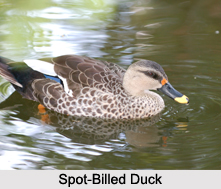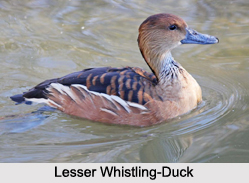 The Indian Subcontinent provides suitable habitat to various species of birds for residing and nesting. Ducks are no exception in this regard. Various species of Ducks have been recorded in different parts of India. These ducks are described below.
The Indian Subcontinent provides suitable habitat to various species of birds for residing and nesting. Ducks are no exception in this regard. Various species of Ducks have been recorded in different parts of India. These ducks are described below.
Spot-Billed Duck
Spot-Billed Duck occupies both inland and coastal wetlands such as creeks, estuaries, etc. Male and female spot-billed ducks differ in terms of physical features. The male duck has a scaly patterned body with a green speculum and a band of white tertials. Its body color is brown-grey. The female duck is browner than its male counterpart with duller patterns. Its dark bill is tipped yellow. The male duck has an orange red patch at the base of the bill.
Lesser Whistling-Duck
Lesser Whistling-Duck occupies areas like freshwater wetlands, lakes, ponds, etc with good vegetative cover. It is chestnut brown in color with chestnut upper tail-coverts. Its eye ring is inconspicuously yellow in color. This duck is small in size measuring about 35 to 45 cm in length and weighing about 450 to 600 grams. The International Union for Conservation of Nature (IUCN) has labeled them as of "least concern`.
White-Headed Duck
 White-Headed Duck has been traced in northwestern India and is listed in the category of endangered birds by the IUCN. It has a length of about 45 to 50 cm giving it the label of being a medium sized bird. It weighs about 500 to 900 grams and has a wingspan of about 60 to 70 cm. The male adult duck is reddish grey in color, with whitish head and black cap on it. Its bill is broad in size and bluish in color. The female counterpart is grayish brown in color and has dark head cap, dark grey bill and a dark stripe on the cheek.
White-Headed Duck has been traced in northwestern India and is listed in the category of endangered birds by the IUCN. It has a length of about 45 to 50 cm giving it the label of being a medium sized bird. It weighs about 500 to 900 grams and has a wingspan of about 60 to 70 cm. The male adult duck is reddish grey in color, with whitish head and black cap on it. Its bill is broad in size and bluish in color. The female counterpart is grayish brown in color and has dark head cap, dark grey bill and a dark stripe on the cheek.
White-Winged Duck
The endangered and large White-Winged Duck can be traced in undisturbed, secluded pools and marshes adjacent to evergreen, deciduous or swamp forests. It is a bird with dark and blackish body color and whitish mottled head and neck. The female duck weighs about 1,700 to 3,600 grams while its male counterpart weighs about 2,200 to 4,300 grams.
Falcated Duck
The medium sized Falcated Duck can be found in wetlands, rivers, streams, flooded grasslands and lakes. The female duck is dark brown, with long grey bill and plumage much like a female wigeon. The eclipse male is similar to the female, but darker on the back and head. Both female and male Falcated Ducks have pale grey underwings, which is visible during their flights.



















